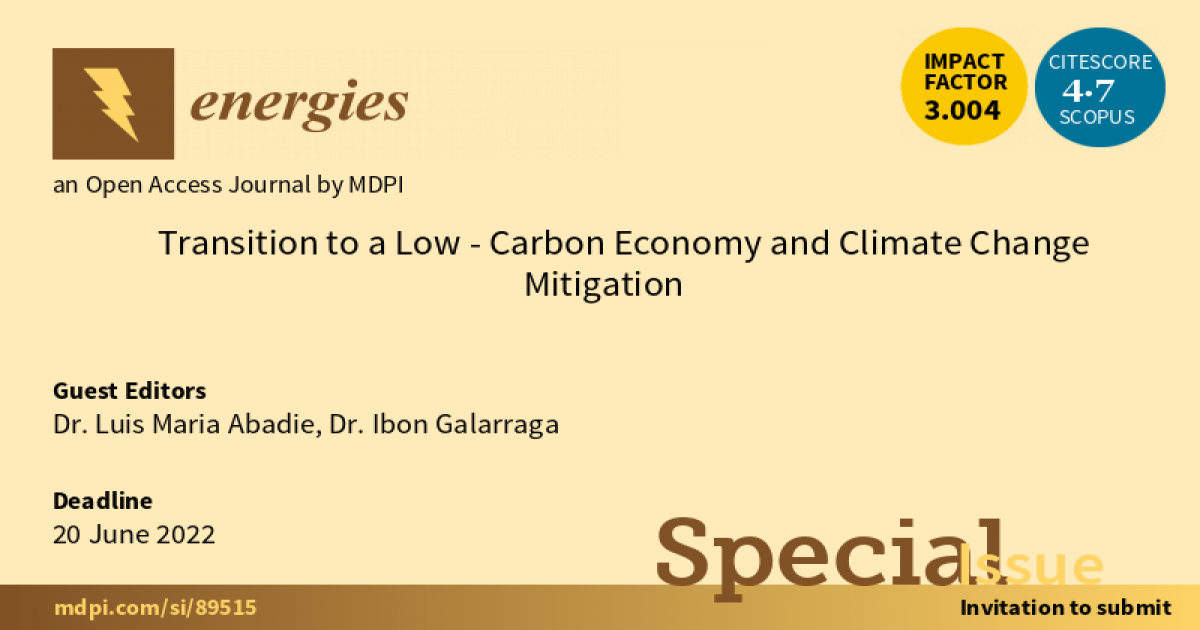Transition to a Low-Carbon Economy and Climate Change Mitigation
A special issue of Energies (ISSN 1996-1073). This special issue belongs to the section "B1: Energy and Climate Change".
Deadline for manuscript submissions: closed (20 June 2022) | Viewed by 30971

Special Issue Editors
Interests: energy economics; carbon markets; GHG emissions; financial economics
Special Issue Information
Dear Colleagues,
Concerns about climate change and the Paris Agreement are leading many countries to set goals close to net-zero emissions in energy systems by 2050. To achieve this objective, many areas are of great interest such as i) the development of renewable technologies, with great technical improvements over time that generate economic advantages; ii) efficiency improvements in both residential and industrial sectors; or iii) alternative modes and energy sources for transportation. This process is accompanied in many countries by carbon pricing mechanisms (carbon tax or carbon markets), as in the case of the European Trading Scheme (ETS). All this drives the decarbonization of energy systems. While in some sectors this decarbonization can be a manageable goal, in other sectors, such as some transportation and industrial sectors that intensively use carbon, this is a difficult goal.
This Special Issue focuses on the developments of technologies and economic instruments and policies to mitigate climate change.
Dr. Luis Maria Abadie
Dr. Ibon Galarraga
Guest Editors
Manuscript Submission Information
Manuscripts should be submitted online at www.mdpi.com by registering and logging in to this website. Once you are registered, click here to go to the submission form. Manuscripts can be submitted until the deadline. All submissions that pass pre-check are peer-reviewed. Accepted papers will be published continuously in the journal (as soon as accepted) and will be listed together on the special issue website. Research articles, review articles as well as short communications are invited. For planned papers, a title and short abstract (about 250 words) can be sent to the Editorial Office for assessment.
Submitted manuscripts should not have been published previously, nor be under consideration for publication elsewhere (except conference proceedings papers). All manuscripts are thoroughly refereed through a single-blind peer-review process. A guide for authors and other relevant information for submission of manuscripts is available on the Instructions for Authors page. Energies is an international peer-reviewed open access semimonthly journal published by MDPI.
Please visit the Instructions for Authors page before submitting a manuscript. The Article Processing Charge (APC) for publication in this open access journal is 2600 CHF (Swiss Francs). Submitted papers should be well formatted and use good English. Authors may use MDPI's English editing service prior to publication or during author revisions.
Keywords
- Electrical systems decarbonization
- Carbon markets
- Carbon tax
- Renewable technological development
- GHG emissions
- Energy efficiency
Benefits of Publishing in a Special Issue
- Ease of navigation: Grouping papers by topic helps scholars navigate broad scope journals more efficiently.
- Greater discoverability: Special Issues support the reach and impact of scientific research. Articles in Special Issues are more discoverable and cited more frequently.
- Expansion of research network: Special Issues facilitate connections among authors, fostering scientific collaborations.
- External promotion: Articles in Special Issues are often promoted through the journal's social media, increasing their visibility.
- Reprint: MDPI Books provides the opportunity to republish successful Special Issues in book format, both online and in print.
Further information on MDPI's Special Issue policies can be found here.






